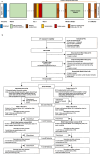A guided single session intervention to reduce intrusive memories of work-related trauma: a randomised controlled trial with healthcare workers in the COVID-19 pandemic
- PMID: 39300443
- PMCID: PMC11414261
- DOI: 10.1186/s12916-024-03569-8
A guided single session intervention to reduce intrusive memories of work-related trauma: a randomised controlled trial with healthcare workers in the COVID-19 pandemic
Abstract
Background: Intrusive memories of psychologically traumatic events bring distress both sub-clinically and clinically. This parallel-group, two-arm randomised controlled trial evaluated the effect of a brief behavioural intervention on reducing intrusive memories in frontline healthcare workers exposed to traumatic events during the COVID-19 pandemic.
Methods: Participants with at least two intrusive memories of work-related trauma in the week before recruitment were randomised 1:1 to an imagery-competing task intervention (n = 73) or attention-based control task (n = 71). The number of intrusive memories was assessed at baseline and 5 weeks after the guided session (primary endpoint).
Results: The intervention significantly reduced intrusive memory frequency compared with control [intervention Mdn = 1.0 (IQR = 0-3), control Mdn = 5.0 (IQR = 1-17); p < 0.0001, IRR = 0.30; 95% CI = 0.17-0.53] and led to fewer post-traumatic stress-related symptoms at 1, 3 and 6 month follow-ups (secondary endpoints). Participants and statisticians were blinded to allocation. Adverse events data were acquired throughout the trial, demonstrating safety. There was high adherence and low attrition.
Conclusions: This brief, single-symptom, repeatable digital intervention for subclinical-to-clinical samples after trauma allows scalability, taking a preventing-to-treating approach after trauma.
Trial registration: 2020-07-06, ClinicalTrials.gov identifier: NCT04460014.
Keywords: Digital intervention; Healthcare workers; Intrusive memory; Mental health; Pandemic; Post-traumatic stress disorder; Prevention-to-treating; Psychological trauma.
© 2024. The Author(s).
Conflict of interest statement
The authors declare the following competing interests: LS is since 2023 an employee of Tobii AB. EAH also receives funding from the Wellcome Trust (223016/Z/21/Z), the Oak Foundation (OCAY-18–442) and Rannís The Icelandic Research Fund; received salary partly funded by the Wellcome Trust (223016/Z/21/Z) via consultancy to P1vital Products Ltd; developed the trademarked imagery-competing task intervention and know-how in using it over the last 20 years (ANEMONE ™); is on the Board of Trustees of the MQ Foundation; reports book royalties from Guildford Press and Oxford University Press, occasional honoraria for conference keynotes and clinical workshops, and occasional consultancy fees from the Swedish agency for health technology assessment and assessment of social services. The other authors report no competing interests.
Figures


References
-
- Colville GA, Smith JG, Brierley J, Citron K, Nguru NM, Shaunak PD, et al. Coping With Staff Burnout and Work-Related Posttraumatic Stress in Intensive Care. Pediatr Crit Care Med J Soc Crit Care Med World Fed Pediatr Intensive Crit Care Soc. 2017;18(7):e267–73. - PubMed
Publication types
MeSH terms
Associated data
LinkOut - more resources
Full Text Sources
Medical

